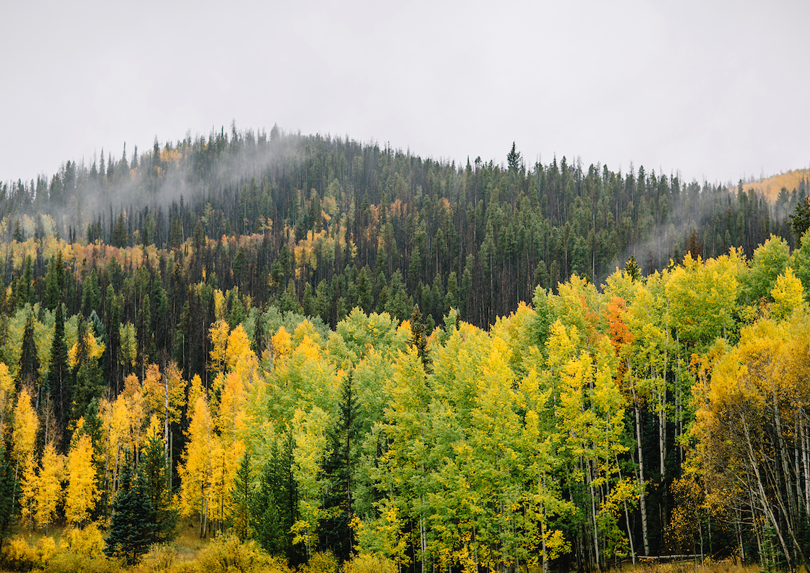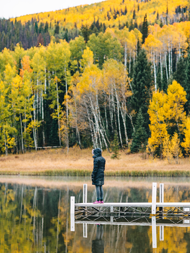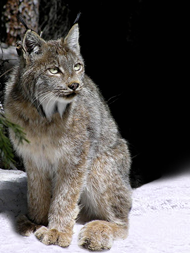
What Is It?
Forest ecosystems are complex habitats defined by the multitude of trees; a continuous strand of trees, with a closed or open canopy, is classified as a forest. The wildlife within forests depends on these trees for food and shelter. In Colorado, forests greatly vary in elevation and supported wildlife species.
What Are Some Examples?
 Aspen - These are upland forests and woodlands dominated by quaking aspen (Populus tremuloides), ranging in elevation from about 7,500 to 10,500 feet.
Aspen - These are upland forests and woodlands dominated by quaking aspen (Populus tremuloides), ranging in elevation from about 7,500 to 10,500 feet.
Ponderosa pine - In Colorado, ponderosa pine
(Pinus ponderosa) woodlands cover about 3.2 million acres. They occur between about 6,000 and 9,000 feet, often at the lower treeline transition between grassland or shrubland and the more mesic coniferous forests above.
Lodgepole pine - Lodgepole pine (Pinus contorta) is widespread between the elevational range of 8,000-10,000 feet. This forest type covers more than two million acres in Colorado. In recent decades, it experienced large scale mortality from mountain pine beetle.
Pinyon-Juniper - This forest type is co-dominated by pinyon pine (Pinus edilus) and several juniper species
(Juniperus spp.). In Colorado, this forest type is found between 4,100-9,000 feet in elevation and covers nearly 7 million acres.
Mixed conifer - Mixed conifer forests occur at elevations ranging from 4,000 to 10,800 feet, and cover more than 850,000 acres in Colorado. Douglas-fir
(Pseudotsuga menziesii) and white fir (Abies concolor) are the most common dominant trees, but as many as seven different conifer species may be present.
Spruce-fir - Spruce-fir forests cover about 5 percent of Colorado’s landscape, forming the matrix vegetation of the sub-alpine zone at elevations of 9,500 to 11,500 feet. They are characterized by dense stands of Engelmann spruce
(Picea engelmannii) and subalpine fir (Abies lasiocarpa).
Learn more about these and other forest habitats in
chapter 3 of the 2015 SWAP.
What Species Depend On This Habitat?
Numerous wildlife species depend on forested habitats to complete all or part of their life cycle requirements. Over 200 species of greatest conservation need are known to use the forests of Colorado. From
lynx and snowshoe
hares in the spruce-fir forest to flammulated owls and Pawnee montane skipper in the ponderosa pine, forests provide important habitat for Colorado’s native wildlife.
What Challenges Does This Landscape Face, and What Is CPW Doing?
 Forested habitats in Colorado face many challenges. The majority of the challenges are associated with land development (residential, transportation and energy), causing fragmentation. Human development has not only modified the footprint of the forested landscapes in Colorado, we have modified the natural processes that have shaped that landscape by suppressing fire. Fire is a natural part of the forested ecosystems that is needed to maintain forested areas.
Forested habitats in Colorado face many challenges. The majority of the challenges are associated with land development (residential, transportation and energy), causing fragmentation. Human development has not only modified the footprint of the forested landscapes in Colorado, we have modified the natural processes that have shaped that landscape by suppressing fire. Fire is a natural part of the forested ecosystems that is needed to maintain forested areas.
Climate change is another challenge for forested ecosystems in Colorado. Climate change may alter natural fire regimes and increase insect outbreaks (severity and duration), further threatening the resiliency of our forested ecosystems.
CPW staff is engaged in helping address these challenges through a number of initiatives. CPW staff are dedicated to improving land through active forest management. Wildlife technicians, biologist, and park staff actively
manage our forested properties for the benefit of wildlife and visitors. We have staff collaborating with other state and federal government agencies to assist in accomplishing forest and fire management on our public lands. CPW
assists private landowners with forest management through our private lands biologists and
Habitat Partnership Program. We also have wildlife researchers conducting projects to better understand wildlife species responses to
large scale insect outbreaks.

